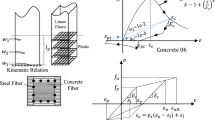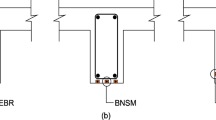Abstract
Traditional adobe masonry wall is made of natural soil, sand, fiber materials without artificial hydraulic binders such as cement, lime and etc. It has been wildly used in residential buildings all over the world for thousands of years. This paper mainly aims at obtaining an insight on the seismic performance of traditional adobe walls subjected to in-plane cyclic loading. Consequently, five 1/2-scale specimens were tested under various levels of vertical stress and height/length ratios. The test results showed that three failure modes including flexural cracking/diagonal shear, rocking/toe crushing/bed joint sliding and rocking/bed joint sliding were observed to be showing horizontal and stair-stepped cracks on the interfaces between block and mortar. The failure mechanism, crack patterns and force–displacement responses were summarized and found to be similar to those of URM walls. However, significant residual displacements under each cyclic loading improved the drift limit and energy-dissipation capacity greatly. The mean value of ultimate linear and peak drift were 0.37 and 1.07 % which were about 3 and 4.5 times greater than those of URM wall. Moreover, the displacement ductility was improved. The values of equivalent viscous damping ratio varied from 0.1 to 0.3 with drift. The damping ratio values were significantly higher than those of URM, and almost equal to those of reinforced masonry walls failing in flexure. Based on test results above, it can be concluded that although lateral force resistance was weaker the deformation resistance and energy-dissipation capacity were higher than those of URM wall.






Similar content being viewed by others

References
Jayasinghe C, Mallawaarachchi RS (2009) Flexural strength of compressed stabilized earth masonry materials. Mater Des 30(9):3859–3868
Kafescioglu R, Guerdal E, Guner A, Akman MS (1983) Adobe blocks stabilzed with gypsum. In: Appropriate building materials for low cost housing: African region, Proceedings of a Symposium. E. & F. N. Spon, London
Lynne E, Cassandra A (2005) Alternative construction: contemporary natural building methods. John Wiley, Hoboken
Morel JC, Pkla A, Walker P (2007) Compressive strength testing of compressed earth blocks. Constr Build Mater 21:303–309
Millogo Y, Morel JC (2012) Microstructural characterization and mechanical properties of cement stabilised adobes. Mater Struct 45(9):1311–1318
Reddy VBV, Lal R, Nanjunda Rao KS (2009) Influence of joint thickness and mortar-block elastic properties on the strength and stresses developed in soil-cement block masonry. J Mater Civil Eng 21(10):535–542
Reddy VBV, Gupta A (2006) Strength and elastic properties of stabilized mud block masonry using cement-soil mortars. J Mater Civil Eng 18(3):472–476
Reddy VBV, Vyas U (2008) Influence of shear bond strength on compressive strength and stress-strain characteristics of masonry. Mater Struct 41(10):1697–1712
Walker P (1995) Strength, durability and shrinkage characteristics of cement stabilized soil blocks. Cement Concr Compos 17(4):201–310
Walker P (2004) Strength and erosion characteristics of earth block masonry. J Mater Civil Eng 11(3):249–256
Fabio T, John EA, Emily S (2009) 2007 August 15 magnitude 7.9 near the coast of Central Peru: analysis and filed mission report. Bull Earthq Eng 7(1):1–70
Gang L, Xiao-yu L, Hong-nan L (2009) Seismic damage investigation and analysis on rural buildings in Wenchuan earthquake. J Dalian Univ Technol 49(5):724–730 (in Chinese)
Maheri MR, Naeim F, Mehrain M (2005) Performance of adobe residential buildings in the 2003 bam, Iran, earthquake. Earthq Spectra 21(S1):337–344
Shen-rong W, Kai C (1987) Experimental studies on shear strength of loess adobe masonry walls. Earthq Resist Eng 3:31–35 (in Chinese)
Silveira D, Varum H, Costa A, Carvalho J (2015) Mechanical properties and behavior of traditional adobe wall panels of the Aveiro district. J Mater Civil Eng 27(9):04014253
Bartolome AS, Quiun D, Zegarra L (2008) Performance of reinforced adobe houses in Pisco, Peru earthquake. In: Proceedings of the 14th world conference on earthquake engineering, Beijing, China
Blondet M, Torrealva D, Ginocchio F, Vargas J, Velásquez J (2006) Seismic reinforcement of adobe houses using external polymer mesh. In: Proceedings of the 8th US national conference on earthquake engineering 2006, Oakland
Blondet M, Vargas J et al (2008) A human development approach for the construction of safe and healthy adobe houses in seismic areas. In: Proceedings of the 14th world conference on earthquake engineering, Beijing, China
Figueiredo A, Varum H, Costa A, Silveira D, Oliveira C (2013) Seismic retrofitting solution of an adobe masonry wall. Mater Struct 46(1–2):203–219
Rojas J, Ferrer H, Cuenca JS (2008) Dynamic behavior of adobe houses in central Mexico. In: Proceedings of the 14th world conference on earthquake engineering, Beijing
Torrealva D, Cerron C, Espinoza Y (2008) Shear and out of plane bending strength of adobe walls externally reinforced with polypropylene grids. In: Proceedings of the 14th world conference on earthquake engineering, Beijing, China
Turanli L, Saritas A (2011) Strengthening the structural behavior of adobe walls through the use of plaster reinforcement mesh. Constr build Mater 25(4):1747–1752
Wu F, Gang L, Hong-nan L, Jin-qing J (2013) Strength and stress-strain characteristics of traditional adobe block and masonry. Mater Struct 46(9):1449–1457
ATC, FEMA (1998) Evaluation of earthquake damaged concrete and masonry wall buildings: basic procedures manual. FEMA 306, Redwood City
ATC, FEMA (1998) Evaluation of earthquake damaged concrete and masonry wall buildings: technical resources. FEMA 307, Redwood City
Bosiljkov V, Page AW, Bokan-Bosiljkov V, Zarnic R (2010) Evaluation of the seismic performance of brick masonry walls. Struct Control Health 17:100–118
Calderini C, Cattari S, Lagomarsino S (2009) In-plane strength of unreinforced masonry piers. Earthq Eng Struct Dyn 38:243–267
Magenes G, Calvi GM (1997) In-plane seismic response of brick masonry walls. Earthq Eng Struct Dyn 26:1097–1111
Abrams DP, Shah N (1992) Cyclic loading testing of unreinforced masonry walls, College of Engineering, University of Illinois at Urbana, Advanced Construction Technology Center Report #92-26-10
Anthoine A, Magonette G, Magenes G (1995) Shear-compression testing and analysis of brick masonry walls. In: Proceedings of the 10th european conference on earthquake engineering, Rotterdam, The Netherlands
Magenes G, Calvi GM (1992) Cyclic behavior of brick masonry walls. In: Proceedings of 10th european conference on earthquake engineering, Duma, The Netherlands
Magenes G, Calvi GM (1992) Cyclic Behavior flexural cracking/diagonal shear of brick masonry walls. In: Proceedings of the 10th european conference on earthquake engineering, Duma, The Netherlands
Tomazevic M (2009) Shear resisitance of masonry walls and Eurocode 6: shear versus tensile strength of masonry. Mater Struct 42:889–907
Tomazevic M, Klemenc I (1997) Seismic behavior of confined masonry walls. Earthq Eng Struct Dyn 26:1059–1071
Paulay T, Priestley MSN (1992) Seismic design of reinforced concrete and masonry building. Wiley, New York
Russell AP, Elwood KJ, Ingham JM (2014) Lateral force-displacement response of unreinforced masonry wall with flanges. J Struct Eng. doi:10.1061/(ASCE)ST.1943-541X.0000863
Vladimir GH, Graca V, Paulo BL (2010) Experimental analysis of reinforced concrete block masonry walls subjected to in-plane cyclic loading. J Struct Eng 136(4):452–462
ASCE, FEMA (2000) Prestandard and commentary for the seismic rehabilitation of buildings. FEMA 356, Washington, DC
Bo-long Z, Ming-shun W, Zhi-xian J (1980) Experimental study on basic behavior of brick masonry under reversed loading. J Tongji Univ 2:1–14 (in Chinese)
Shedid MT, EI-Dakhakhni WW, Drysdale RG (2009) Behavior of fully grouted reinforced concrete masonry shear walls failing in flexure: analysis. Eng Struct 31:2032–2044
Author information
Authors and Affiliations
Corresponding author
Rights and permissions
About this article
Cite this article
Wu, F., Wang, HT., Li, G. et al. Seismic performance of traditional adobe masonry walls subjected to in-plane cyclic loading. Mater Struct 50, 69 (2017). https://doi.org/10.1617/s11527-016-0927-0
Received:
Accepted:
Published:
DOI: https://doi.org/10.1617/s11527-016-0927-0



